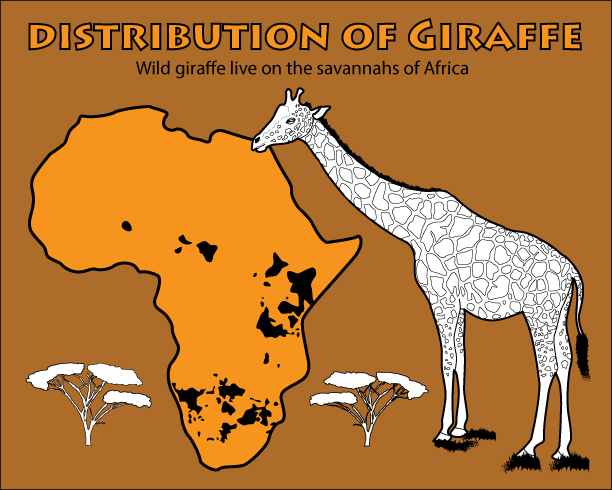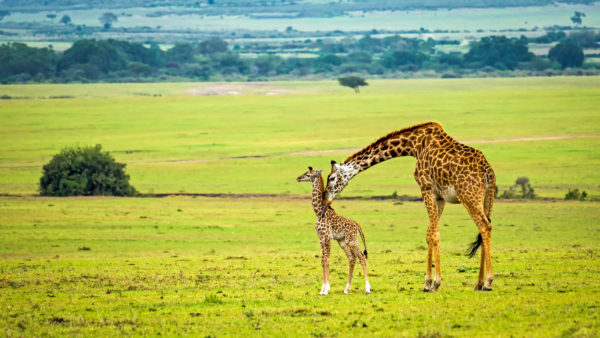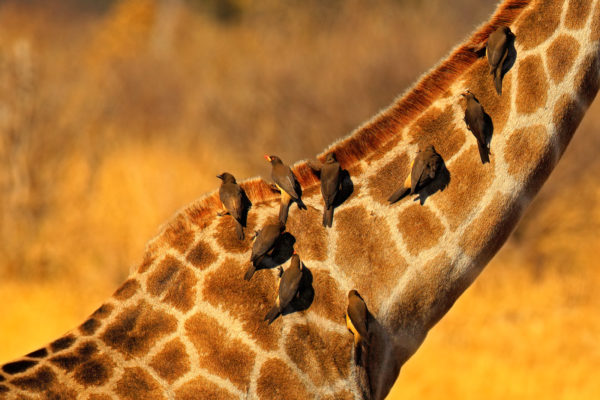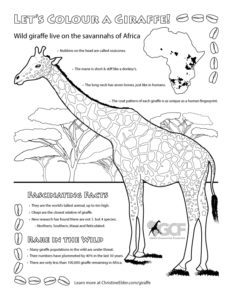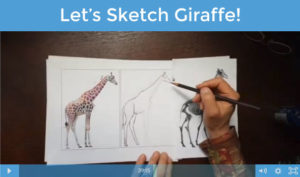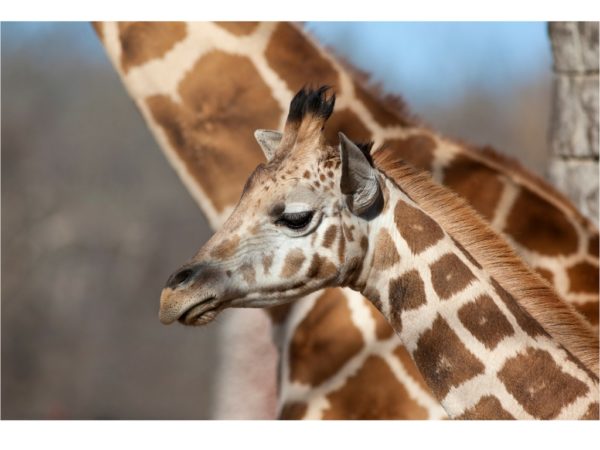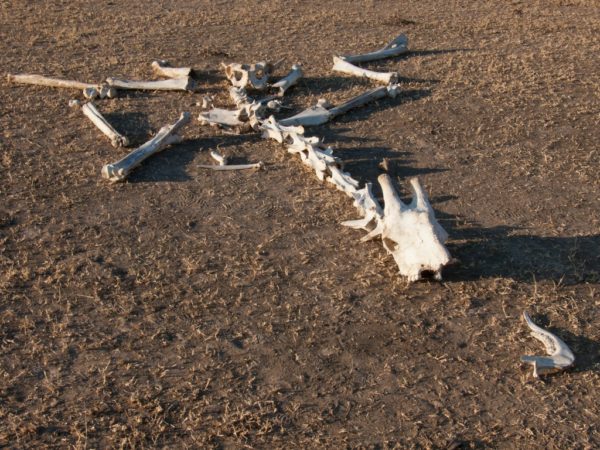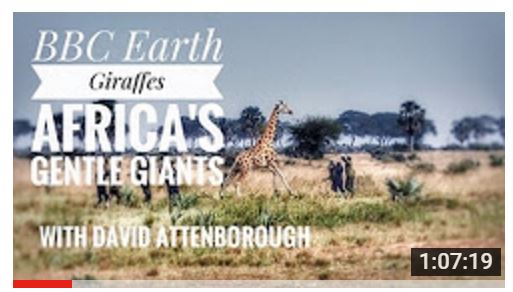World Giraffe Day is observed annually on June 21st; the longest day of the year, to celebrate the animal with the longest neck!
I’ve assembled some facts and resources on giraffe biology, ecology, anatomy, and conservation. You’ll also find here a giraffe coloring page I’ve designed for kids as well as sketching workshop where I teach you all about giraffes and lead you through a step-by-step demonstration on how to draw these gentle giants of the African savannas.
What Giraffe Look Like
-Giraffes are even-toed ungulates, in the same order as cattle, hippos, goats, and sheep. Their closest relative is the Okapi, who also lives in Africa.
-They are the world’s tallest animals, some reaching up to 19 feet high.
-The pair of horn-like structures on their heads are called ossicones. Both males and females have them, though males are larger. They are made of cartilage and are covered by skin and fur.
– Ossicones vary in number depending upon the type of giraffe; the Rothchild’s Giraffe has 5 altogether, while others have 3.
-The coat pattern is as unique as a human fingerprint, which enables researchers to identify and study individual animals throughout their lives. And the patterns vary slightly between species as well.
-The long neck has seven bones, just like in humans, but they are much larger and stronger.
-The mane is short & stiff like a donkey’s.
-Males differ from females in being taller, heavier, and having larger ossicones.
-A giraffe has the largest heart of any land mammal, weighing up to 25 pounds!
-Their hides are very thick and tough, to protect from both predators and the sharp spines on the plants they browse upon, like Acacia trees.
-Their feet are the size of dinner plates!
-A giraffe’s front legs are longer than their rear legs. So, in order to drink, a giraffe must splay its legs out because even though their necks appear very long, they still aren’t long enough to reach the ground.
-Their tongue is black, due to the pigment melanin. This pigment serves the same function in human skin, helping to toughen and protect it from sunburn.
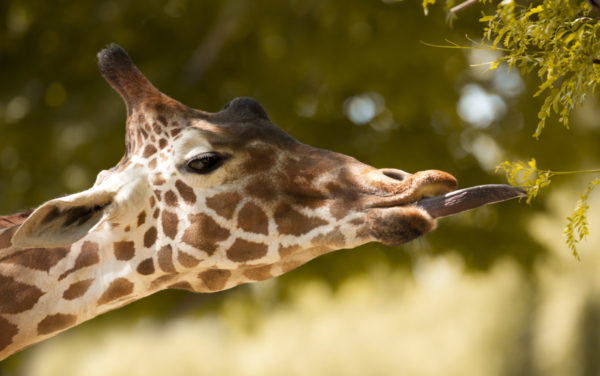
About Baby Giraffe
– A mother giraffe is pregnant for 400-460 days, usually with just one calf.
-The calf is born while the mother is standing up, coming out front hooves first.
– At birth, the giraffe calf weighs around 150 pounds and is six feet tall.
-The baby can stand on its own and nurse within 30 minutes and can run within 10 hours.
-The giraffe calf will nurse until the mother weans it around 10-16 months.
-They reach full maturity by about 5 years old and normally live into their twenties.
What Giraffe Eat and Who Eats Them
– Giraffes are ruminants, and like cattle, have four stomachs and chew their cud, which helps them to get more nutrients out of their diet. They eat and digest food similar to a cow, chewing and swallowing, then regurgitating the partially digested cud back into their mouth to chew it again, which helps to release more nutrients from the food they eat.
– Giraffes are browsers of leaves, not grazers of grass, and being the tallest of Africa’s animals, allows them to eat food no other browser can reach.
– Giraffe’s favorite food are leaves of the Acacia tree. They may eat between 50-75 pounds of leaves every day!
– They roam long distances in search of food, up to 11,000 square kilometers.
– Their tongue is long, strong and nimble, helping them to reach the most inaccessible leaves.

– Their coat is thick and tough, protecting them from the sharp spines of trees and the long claws of predators.
– The giraffe’s main predator is the African Lion, which mainly takes small calves and injured adults. Other predators include hyenas, leopards, and crocodiles.
– Once a giraffe reaches adulthood it is safer from predators, but still protects itself from this threat by taking turns being on the lookout, especially when the herd is sleeping or drinking at a watering hole.
-Their constant companions are birds known as oxpeckers, whose role is to keep the giraffe free of parasites like ticks, of which they can eat up to 400 per day! However, the birds are both a blessing and a curse since they sometimes get carried away and will peck holes in the mammals’ hide to lap up the nutritious blood.
Little Known Facts About Giraffes
– Recent genetic research by the Giraffe Conservation Foundation has determined that there are 4 species of giraffe, not 1 as previously thought. They include the Southern Giraffe, Northern Giraffe, Reticulated Giraffe and Masai Giraffe; each of whom lives in a different region of Africa and has a slightly different coat color and pattern of spots.
– Giraffe can regulate their body temperature with a fine network of blood vessels under the colored patches on their skin.
– They serve as vital pollinators and seed dispersers of the plants they browse on.

– They are not mute, as some people assume; but can make a variety of sounds including bleats, grunts, snorts, moans, and hisses.
– A giraffe only needs to sleep around 30 minutes per day, broken into short cat-naps throughout a 24-hour period.
– Males engage in battle by hitting each other with their powerful necks.
-A unique scent from skin alkaloids may function as an antimicrobial and parasite repellant. It is said that the two alkaloids make giraffe smell like a mix of feces and jasmine or orange blossoms, can you imagine that?
-They walk using a unique ‘pace’ with legs on the same side moving forward at the same time. They lack a trotting gait, only walking and galloping. Here’s a cool animation clip showing their pace walk.
Giraffe Coloring Page
I have created a coloring page that you are free to download and enjoy. It is loosely based on what a Reticulated Giraffe species, looks like, set in her native home on the savannas of Kenya. The Giraffe Conservation Foundation in Africa collaborated with me to ensure the accuracy of this resource I created for you.
Download the Giraffe Coloring Page
Learn to Sketch Giraffe
Visit this page of my website, How to Sketch Giraffe, for a video tutorial all about drawing a giraffe. It includes a thorough introduction to giraffe biology and anatomy to help you understand their structure, which will aid you in creating a realistic drawing of giraffe, whether you’re at a zoo or on a safari!
Giraffe Conservation Challenges
Many giraffe populations in the wild are under threat. Their numbers have plummeted by 40% in the last 30 years alone. Less than 100,000 giraffe remain in the wild and they have already gone extinct in 7 countries where they once roamed.
Reasons for the decline of giraffe populations are many. Primarily, they are losing habitat due to human population growth, which leads to both degradation of their habitat and hunting of the animals for food. Their habitat is rapidly being converted into farms and mined for its oil and minerals. Woodlands are logged for their timber, and trees are collected for firewood and to turn into charcoal.
As herds of giraffe get separated into smaller populations, they are even more in danger of becoming locally extinct and at risk of inbreeding, which weakens the genetic diversity of the herd.
Clearing land for new settlements and farms and overgrazing by cattle put more pressure on the savannas that giraffes call home. Widespread droughts and wildfires have also taken a toll on these magnificent, once abundant mammals, and will only get worse with the effects of global climate change.
Political coups and civil unrest in several African nations lead to indiscriminate and short-sighted exploitation of many natural resources and an increase in hunting of giraffe for food and poaching. Tragically, over 1,000 rangers have been killed by poachers in Africa, while defending giraffe and other vulnerable wildlife.
Other reasons for declines in giraffe include disease, lack of water due to diversions for agriculture, and deaths from snares set by poachers.
Learn More about Giraffes and their Conservation
- Encyclopedia of Life
- Giraffe Conservation Foundation
- African Wildlife Foundation
- Wild Nature Institute
- Giraffe Alliance
To learn more about giraffes, I highly recommend this David Attenborough film, Giraffe: Africa’s Gentle Giants, which centers on the work of Dr. Julian Fennessy and his wife Stephanie, founders of the Giraffe Conservation Foundation, and their long-time dedication to studying and conserving Africa’s giraffes.
If you liked this story on giraffes, you may enjoy my story on rhinos too! Click here to learn about rhinos.
Did You Enjoy This Story?
If you’ve found value in this story and believe in my mission to educate youth and adults alike on the value of nature, I invite you to make a donation to help broaden and deepen the work I can accomplish.
Click the Paypal ‘Donate’ button below to donate any amount you wish to support the conservation and education work I do. You don’t need to have a Paypal account to donate, you may also choose to use a credit card, or simply send put a check in the mailbox if you wish. Thank you!


